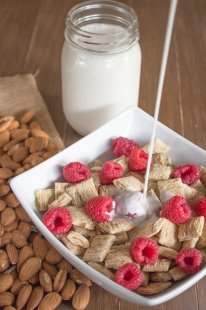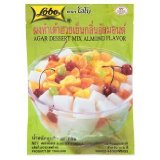Almond milk Creamer recipe
 Today’s lesson, students, is all about the science of viscosity. Viscosity is, of course, the term that refers to the thickness of a liquid. The thicker the liquid, the more “viscous” it is said to be. Cream is more viscous than water, and molasses is more viscous than cream. Make sense?
Today’s lesson, students, is all about the science of viscosity. Viscosity is, of course, the term that refers to the thickness of a liquid. The thicker the liquid, the more “viscous” it is said to be. Cream is more viscous than water, and molasses is more viscous than cream. Make sense?
All this talk about viscosity has everything to do with the fatal flaw of homemade almond milk: it has none. Almond milk is naturally as thin as water – “almond tea” might be a better term for this beverage. It has the right flavors, but none of the creaminess that we expect from milk. Commercial producers of almond milk are well aware of this problem and add carrageenan (you’ve heard of that recently, haven’t you?) as a gelling agent to increase its viscosity and emulate the mouthfeel of thick, fatty, “viscous” whole milk. The debate about carrageenan’s safety aside (it’s not as bad as it seems), your only other option is to follow one of the myriad homemade almond milk recipes online and enjoy your pitcher of watery almond tea.
This problem has puzzled me for months. I’ve often wondered how to naturally thicken my homemade almond milk without chemical additives, but nothing worked. Then, as is always the case with scientific discoveries that forever change the course of humanity (like this one), it happened completely on accident. I had just made a fresh batch of watery homemade almond milk and used it to make my afternoon chai tea latte. As this began to cool in my mug I noticed something interesting: the liquid was… thick! Not just a little thicker, but as thick as heavy cream.
I immediately went back to the kitchen and tried to figure out what I did to cause this thickening. It wasn’t anything I added, like the tea, it couldn’t be the whisking, what about the… heat? Surely, bringing the almond milk to just under a boil couldn’t permanently increase its viscosity, could it? It turns out, that’s exactly what happens. By some bizarre chemistry, the particles in the almonds thicken the liquid when exposed to heat. And lest you think we’re just reducing the mixture (i.e. evaporating the water to make it thicker), this is certainly not the case because the milk is only heated for a few minutes.
I don’t fully understand the chemistry of what’s happening, but I did do some very nerdy scientific viscosity experiments that gave me conclusive evidence: unheated almond milk is as thin as water, but heated almond milk remains 50% thicker and more viscous at the same temperatures. Go figure.
Makes about 6 cups
Ingredients:
- 1.5 cups almonds
- 6 cups filtered water
- 1/4 teaspoon salt
- Vanilla extract (optional)
- Maple syrup (optional)
Equipment
This recipe does require some unique kitchen tools. You’ll need a blender and large pot, which you likely already have, but you also need a fine mesh filter bag to strain the blended almond pulp out of the finished milk. You can buy these reusable nut milk bags online for like $7-15 each (at Amazon here) or you can simply go to your local hardware store and buy paint filter bags that cost about $1 each. I don’t know if they’re necessarily “food grade” but I soak mine in hot soapy water a few times before use and they do just fine.
Step One
Soak the almonds for at least 6 hours; 10-12 is even better. As the almonds soak, they become softer and absorb much of the water. This allows them to break down better and impart more flavor into the milk when blended.
Step Two
When thoroughly soaked, drain and rinse the almonds. Then add them to a large blender with water and salt (a Vitamix can handle the full batch, but you may have to do 2 batches with a smaller blender). Blend for at least 2-3 minutes to fully break down the almonds. Allow this to rest for 5-10 minutes to “steep” (much like tea) to get the most flavor.
Step Three
Grab your handy milk straining bag (or paint filter bag) and strain the mixture through this bag and into a large pitcher below. Go slowly and use your hands to squeeze the almond pulp and extract all the liquid. This process kind of resembles milking a cow (which is really ironic) but let’s not go there… When all the milk is strained you’ll be left with a chunk of almond pulp. You can discard this, use it to make things like pates, or even dehydrate it and use it as almond flour.
Give the milk a taste and stir in any flavorings you’d like. I often add a little vanilla and maple syrup.
Step Four
Now for the fun part! In my multiple experiments with this process, I have noticed that the thickening reaction happens quite suddenly at the right temperature and produces a liquid that is REALLY thick when cooled (more viscous than heavy cream). Depending on your usage, this can actually be too thick and impractical. The best way to control the viscosity is to reserve some of the almond milk in its unthickened state, heat and thicken the other part, then combine them together for the perfect consistency of whole milk.
More

|
Lobo Agar Dessert Mix Almond Flavour for 4-6 Servings 130g. (4.55oz ) Pack of 3 Grocery (Thailand)
|





